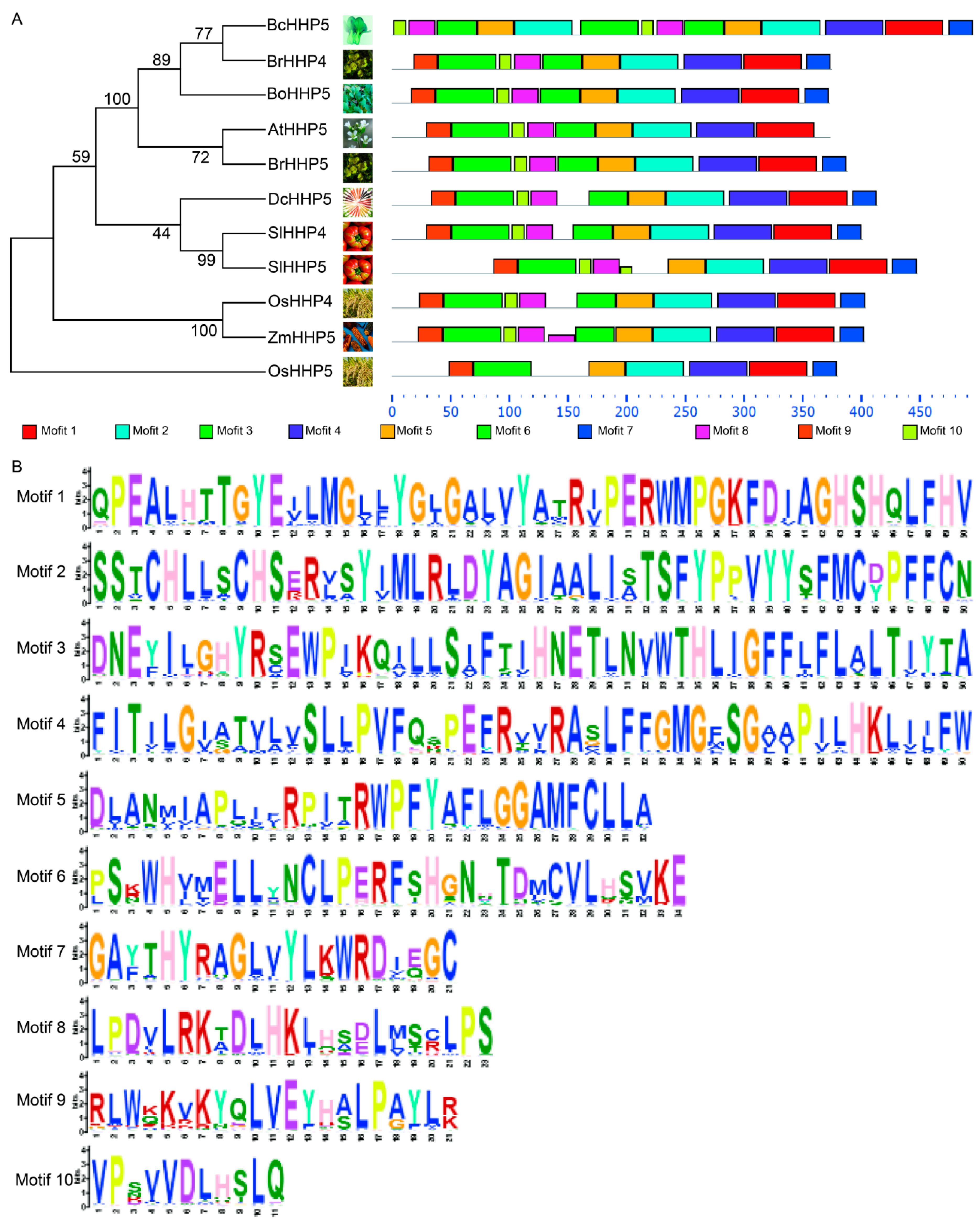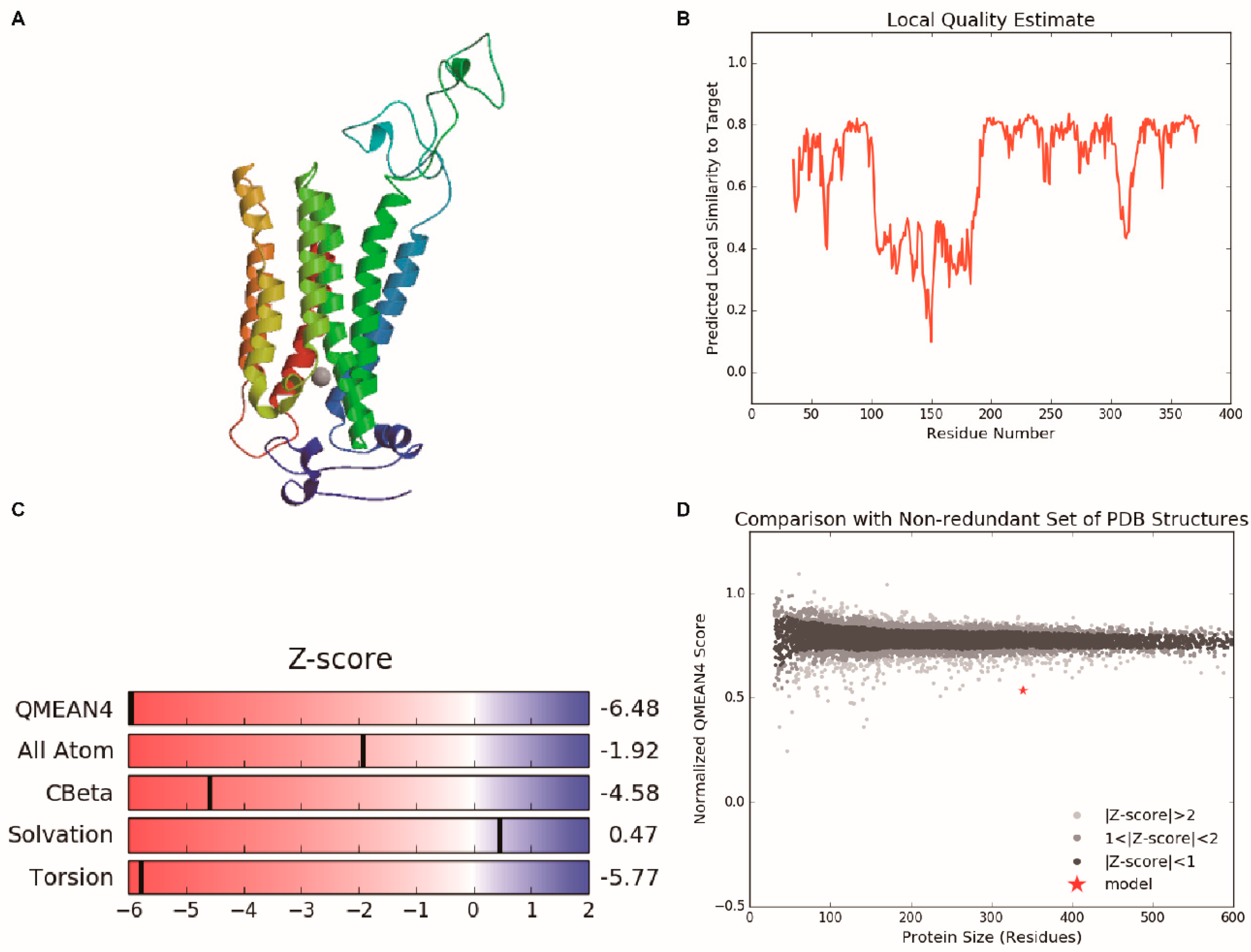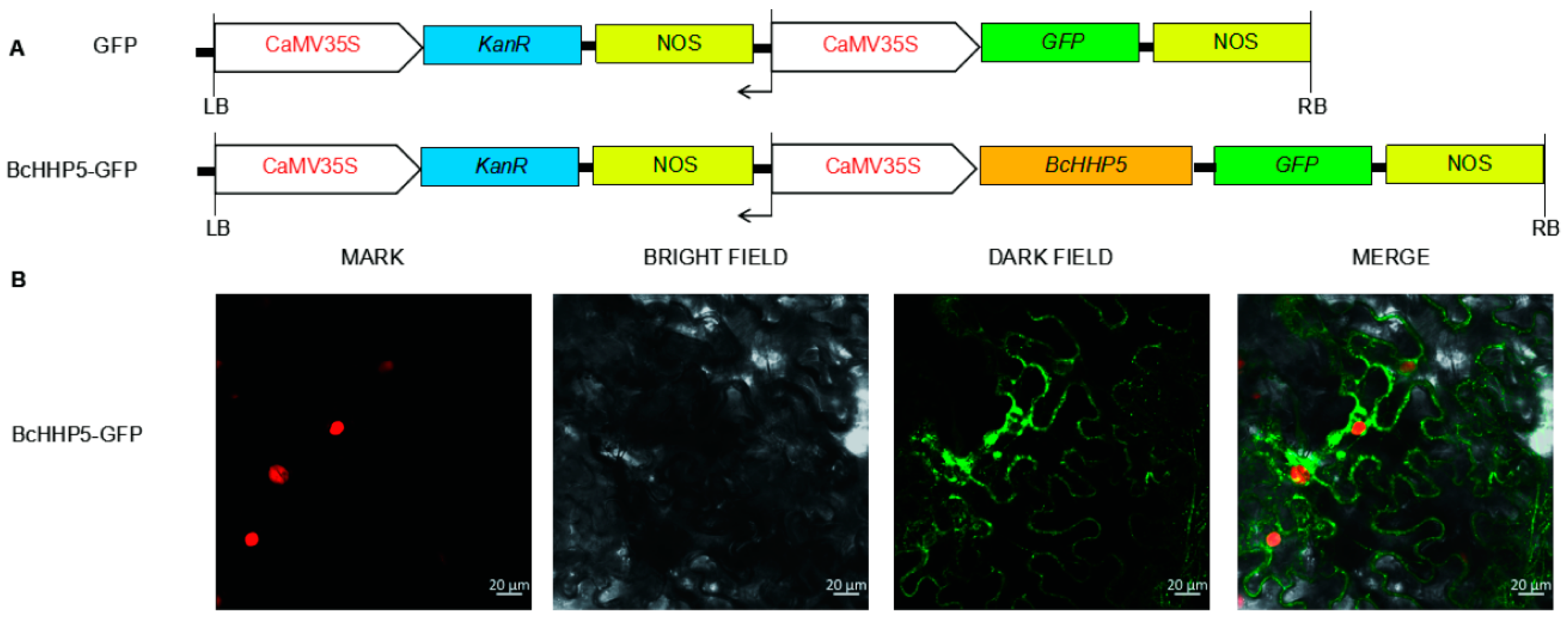Identification and Functional Characterization of a Cold-Related Protein, BcHHP5, in Pak-Choi (Brassica rapa ssp. chinensis)
Abstract
1. Introduction
2. Results
2.1. Isolation and Multiple Sequence Alignment of BcHHP5
2.2. Phylogenetic Analysis and Motif Analysis
2.3. Structure Analysis of BcHHP5 Protein
2.4. Transmembrane Domain, Signal Peptide, Hydrophilicity, and Subcellular Localization Prediction Analysis
2.5. Localization Analysis of BcHHP5 Protein
2.6. Expression Levels of the BcHHP5 Gene in Pak-Choi
2.7. Virus-Induced BcHHP5 Silencing Reduced Response to Cold Tolerance
3. Discussion
4. Material and Methods
4.1. Cloning, Multiple Sequence Alignment, and Phylogenetic Analysis
4.2. Plant Materials, Growing Environment, and Adversity
4.3. BcHHP5 Protein Structural Analysis in Pak-Choi
4.4. Transmembrane Domain, Signal Peptide, Hydrophilicity, and Subcellular Localization Prediction Analysis
4.5. Localization Method of 35S: BcHHP5-GFP
4.6. Cold, NaCl, ABA, and SA Treatments in Pak-Choi
4.7. Physiological Analyses and Data Analysis
4.8. Silencing Expression of BcHHP5 Gene in Pak-Choi
5. Conclusions
Author Contributions
Funding
Acknowledgments
Conflicts of Interest
Abbreviations
| ABA | abscisic acid |
| ANOVA | analysis of variance |
| bp | base pair |
| CBF | c-repeat-binding factor |
| COR | cold-regulated |
| GFP | green fluorescent protein |
| HHP | Heptahelical protein |
| NJ | Neighbor-Joining |
| ORF | open reading frame |
| PDS | Phytoene desaturase |
| RT-qPCR | real-time quantitative polymerase chain reaction |
| SA | salicylic acid |
| TYMV-VIGS | turnip yellow mosaic virus-induced gene silencing |
References
- Chinnusamy, V.; Zhu, J.; Zhu, J.K. Cold stress regulation of gene expression in plants. Trends Plant Sci. 2007, 12, 444–451. [Google Scholar] [CrossRef] [PubMed]
- Gustafsson, H. Signal transduction during cold, salt, and drought stresses in plants. Mol. Biol. Rep. 2012, 39, 969–987. [Google Scholar]
- Zinn, K.E.; TuncOzdemir, M.; Harper, J.F. Temperature stress and plant sexual reproduction: Uncovering the weakest links. J. Exp. Bot. 2010, 61, 1959–1968. [Google Scholar] [CrossRef]
- Barnes, A.C.; Benning, C.; Roston, R.L. Chloroplast membrane remodeling during freezing stress is accompanied by cytoplasmic acidification activating SENSITIVE TO FREEZING2. Plant Physiol. 2016, 171, 2140–2149. [Google Scholar] [CrossRef] [PubMed]
- Chinnusamy, V.; Jagendorf, A.; Zhu, J. Understanding and improving salt tolerance in plants. Crop Sci. 2005, 45, 437–448. [Google Scholar] [CrossRef]
- Yamaguchishinozaki, K.; Shinozaki, K. Transcriptional regulatory networks in cellular responses and tolerance to dehydration and cold stresses. Annu. Rev. Plant Biol. 2006, 57, 781–803. [Google Scholar] [CrossRef]
- Thomashow, M.F. Plant cold acclimation: Freezing tolerance genes and regulatory mechanisms. Annu. Rev. plant Physiol. 1999, 50, 571–599. [Google Scholar] [CrossRef] [PubMed]
- Nakashima, K.; Yamaguchi-Shinozaki, K. Transcriptional regulatory networks in response to abiotic stresses in Arabidopsis and grasses. Plant Physiol. 2009, 149, 88–95. [Google Scholar] [CrossRef] [PubMed]
- Hsieh, M.H.; Goodman, H.M. A novel gene family in Arabidopsis encoding putative heptahelical transmembrane proteins homologous to human adiponectin receptors and progestin receptors. J. Exp. Bot. 2005, 56, 3137–3147. [Google Scholar] [CrossRef]
- Smb, M.; Chi, Y.H.; Pham, T.T.; Paeng, S.K.; Wi, S.D.; Lee, C.; Ryu, S.W.; Koo, S.S.; Lee, S.Y. RNA Chaperone function of a universal stress protein in arabidopsis confers enhanced cold stress tolerance in plants. Int. J. Mol. Sci. 2017, 18, 2546. [Google Scholar]
- Chen, C.C.; Liang, C.S.; Ai-Ling, K.; Yang, C.C. HHP1 is involved in osmotic stress sensitivity inArabidopsis. J. Exp. Bot. 2009, 60, 1589–1604. [Google Scholar] [CrossRef] [PubMed]
- Chen, C.C.; Liang, C.S.; Kao, A.L.; Yang, C.C. HHP1, a novel signalling component in the cross-talk between the cold and osmotic signalling pathways in Arabidopsis. J. Exp. Bot. 2010, 61, 3305–3320. [Google Scholar] [CrossRef] [PubMed]
- Tang, J.; Wang, F.; Wang, Z.; Huang, Z.; Xiong, A.; Hou, X. Characterization and co-expression analysis of WRKY orthologs involved in responses to multiple abiotic stresses in Pak-choi (Brassica campestris ssp. chinensis). BMC Plant Biol. 2013, 13, 188. [Google Scholar] [CrossRef] [PubMed]
- Herman, I.M. Actin isoforms. Curr. Opin. Cell Biol. 1993, 5, 48–55. [Google Scholar] [CrossRef]
- Bailey, T.L.; Williams, N.; Misleh, C.; Li, W.W. MEME: Discovering and analyzing DNA and protein sequence motifs. Nucleic Acids Res. 2006, 34, W369–W373. [Google Scholar] [CrossRef]
- Liu, C.; Wang, X.; Xu, Y.; Deng, X.; Xu, Q. Genome-wide analysis of the R2R3-MYB transcription factor gene family in sweet orange (Citrus sinensis). Mol. Biol. Rep. 2014, 41, 6769–6785. [Google Scholar] [CrossRef]
- Sundararajan, S. Fast Learning Optimized Prediction Methodology for Protein Secondary Structure Prediction, Relative Solvent Accessibility Prediction and Phosphorylation Prediction; Iowa State University: Ames, IA, USA, 2011. [Google Scholar]
- Sakai, K. Apparatus and method for predicting three-dimensional structure of protein. U.S. Patent Application No 10/864, 335, 31 March 2005. [Google Scholar]
- Gaoyan, Q.; Zejian, G. Study of subcellular localization of rice oswrky gene. J. Shandong Agric. Univ. 2002, 33, 506–508. [Google Scholar]
- Liu, W.; Yu, K.; He, T.; Li, F.; Zhang, D.; Liu, J. The low temperature induced physiological responses of Avena nuda L., a cold-tolerant plant species. Sci. World J. 2013, 2013, 658793. [Google Scholar]
- Londo, J.P.; Kovaleski, A.P.; Lillis, J.A. Divergence in the transcriptional landscape between low temperature and freeze shock in cultivated grapevine (Vitis vinifera). Hortic. Res. 2018, 5, 10. [Google Scholar] [CrossRef]
- Scott, M.; Oomen, R.; Thomas, D.; Hallett, M. Predicting the subcellular localization of viral proteins within a mammalian host cell. Virol. J. 2006, 3, 1–8. [Google Scholar] [CrossRef]
- Qu, Y.; Zhou, A.; Zhang, X.; Tang, H.; Liang, M.; Han, H.; Zuo, Y. De novo transcriptome sequencing of low temperature-treated Phlox subulata and analysis of the genes involved in cold stress. Int. J. Mol. Sci. 2015, 16, 9732–9748. [Google Scholar] [CrossRef] [PubMed]
- Wei, Y.; Wei, H.; Xia, F.; Zeng, H.; Li, X.; Yu, Y.; He, C.; Shi, H. Heat shock transcription factors in banana: Genome-wide characterization and expression profile analysis during development and stress response. Sci. Rep. 2016, 6, 36864. [Google Scholar] [CrossRef]
- Huang, F.; Tang, J.; Hou, X. Molecular cloning and characterization of BcCSP1, a Pak-choi (Brassica rapa ssp. chinensis) cold shock protein gene highly co-expressed under ABA and cold stimulation. Acta Physiol. Plant. 2016, 38, 1–8. [Google Scholar]
- Zhang, J.Y.; Qiao, Y.S.; Lv, D.; Gao, Z.H.; Qu, S.C.; Zhang, Z. Malus hupehensis NPR1 induces pathogenesis-related protein gene expression in transgenic tobacco. Plant Biol. 2012, 14, 46–56. [Google Scholar] [CrossRef] [PubMed]
- Wang, Z.; Wang, F.; Tang, J.; Huang, Z.; Xiong, A.; Hou, X. C-repeat binding factor gene family identified in non-heading Chinese cabbage is functional in abiotic and biotic stress response but different from that in Arabidopsis. Acta Physiol. Plant. 2014, 36, 3217–3229. [Google Scholar] [CrossRef]
- Miura, K.; Furumoto, T. Cold signaling and cold response in plants. Int. J. Mol. Sci. 2013, 14, 5312–5337. [Google Scholar] [CrossRef] [PubMed]
- Livak, K.J.; Schmittgen, T.D. Analysis of relative gene expression data using real-time quantitative PCR and the 2 −ΔΔCT Method. Methods 2012, 25, 402–408. [Google Scholar] [CrossRef] [PubMed]
- Shi, Y.; Tian, S.; Hou, L.; Huang, X.; Zhang, X.; Guo, H.; Yang, S. Ethylene signaling negatively regulates freezing tolerance by repressing expression of CBF and type-A ARR genes in Arabidopsis. Plant Cell 2012, 24, 2578–2595. [Google Scholar] [CrossRef]
- Dexter, S.T.; Tottingham, W.E.; Graber, L.F. Preliminary results in measuring the hardiness of plants. Plant Physiol. 1930, 5, 215–223. [Google Scholar] [CrossRef]
- Dexter, S.T.; Tottingham, W.E.; Graber, L.F. Investigations of the hardiness of plants by measurement of electrical conductivity. Plant Physiol. 1932, 7, 63–78. [Google Scholar] [CrossRef]
- PérezHarguindeguy, N.; Díaz, S.; Garnier, E.; Lavorel, S.; Poorter, H.; Jaureguiberry, P. New handbook for standardised measurement of plant functional traits worldwide. Aust. J. Bot. 2013, 61, 167–234. [Google Scholar]
- Ding, Y.; Li, H.; Zhang, X.; Xie, Q.; Gong, Z.; Yang, S. OST1 kinase modulates freezing tolerance by enhancing ICE1 stability in Arabidopsis. Dev. Cell 2015, 32, 278–289. [Google Scholar] [CrossRef] [PubMed]
- Ruggieri, G.M.; Triassi, A.; Alvarez, C.E.; Gola, A.; Wiggenhauser, J.; Budde, C.O.; Lara, M.V.; Drincovich, M.F.; Müller, G.L. Overexpression of glycine-rich RNA-binding protein in tomato renders fruits with higher protein content after cold storage. Biol. Plant. 2018, 62, 501–510. [Google Scholar] [CrossRef]
- Pflieger, S.; Blanchet, S.; Camborde, L.; Drugeon, G.; Rousseau, A.; Noizet, M.; Planchais, S.; Jupin, I. Efficient virus-induced gene silencing in Arabidopsis using a ‘one-step’ TYMV-derived vector. Plant J. 2010, 56, 678–690. [Google Scholar] [CrossRef] [PubMed]
- Hamada, H.; Linghu, Q.; Nagira, Y.; Miki, R.; Taoka, N.; Imai, R. An in planta biolistic method for stable wheat transformation. Sci. Rep. 2017, 7, 11443. [Google Scholar] [CrossRef] [PubMed]








| Primer Name | Primer Sequences (5′-3′) |
|---|---|
| Cloning | |
| BcHHP5-F | ATGAAACCCAGCGTTGTTGATC |
| BcHHP5-R | TCAACATCCTTCAATGTCTCTCCAC |
| Gateway Cloning | |
| gBcHHP5-F | GGGGACAAGTTTGTACAAAAAAGCAGG |
| CTTCATGAAACCCAGCGTTGTTGATC | |
| gBcHHP5-R | GGGGACCACTTTGTACAAGAAAGCTGGG |
| TGTCAACATCCTTCAATGTCTCTCCAC | |
| RT-qPCR | |
| qBcHHP5-F | CATAATGCTAAGGCTTGACT |
| qBcHHP5-R | GAAGATGCTGAGGAGGAT |
| qBcPDS-F | CAAAATGGGGTTTTGGAGGC |
| qBcPDS-R | TGCAGGACGAGGAGCACTACG |
| qBcACTIN-F | GTTGCTATCCAGGCTGTTCT |
| qBcACTIN-R | AGCGTGAGGAAGAGCATAAC |
| Name | GenBank Accession | Protein Sequence |
|---|---|---|
| AtHHP5 | AT4G38320 | MGDEAEIKEHLKPQASSETIDKKHNVKGKRLWQKVKYQLVEFHSLPAYLRDNEYIIGHYRSEWPIKQILLSIFTIHNETLNVWTHLIGFFLFLALTIYTATKVPSVVDLHSLQHRLPDLLRKTDLHKLHSELMSRLPSSPSSWHVMDLLYNCLPERFSHGNYTDMCVLHSVREDLANLIAPLIFRPITRWPFYAFLGGAIFCLLASSTCHLLSCHSERVSYIMLRLDYAGIAALIATSFYPPVYYSFMCDPFFCNLYLGFITILGIATVLVSLLPVFQSLEFRVVRASLFFGMGFSGLAPILHKLIIFWDQPEALHMTGYEILMGLLYGLGAVVYATRIPERWMPGKFDIAGHSHQLFHVLVVAGALTHYRAGL |
| BcHHP5 | CabbageG_a_f_g000167 | MKPSVVDLHSLQHRLPDVLRKTDLHKLHSDLMSRLPSSPSKWHVMELLYNCLPERFSHGNNTDMCVLHSVKEDLANMIAPLIFRPITRWPFYAFLGGAMFCLLASSTCHLLSCHSERVSYIMLRLDYAGIAALISTSFYPPVYYSFMIHNNLGNLHVYLRDNEYILGHYRSEWPIKQILLSIFTIHNETLNVWTHLIGFFLFLALTIYTATKVPSVVDLHSLQHRLPDVPRKTDLHKLHSDLMSRLPSSPSKWHVMELLYNCLPERFSHGNNTDMCVLHSVKEDLANMIAPLIFRPITRWPFYAFLGGAMFCLLASSTCHLLSCHSERVSYIMLRLDYAGIAALISTSFYPPVYYSFMCDPFFCNLYLGFITILGISTVLVSLLPVFQSPEFRVVRASLFFGMGFSGAAPILHKLIIFWDQPEALHTTGYEVLMGLLYGLGALVYATRIPERWMPGKFDIAGHSHQLFHVLVVAGAFTHYRAGLVYLKWRDIEGC |
| BoHHP5 | Bol028895 | MGGEAEVKERLQPKGKRLWQKVKYQLVEYHALPAYLRDNEYILGHYRSEWPIKQILLSIFTIHNETLNVWTHLIGFFLFLALTIYTATKVPSVVDLHSLQHRLPDLLRKTDLHKLHSDLMSRLPSSPSKWHVMELLYNCLPERFSHGNSTDMCVLHSVKEDLANMIAPLIFRPITRWPFYAFLGGAMFCLLASSTCHLLSCHSERVSYIMLRLDYAGIAALISTSFYPPVYYSFMCDPFFCNLYLGFITILGISTVLVSLLPVFQSPEFRVVRASLFFGMGFSGAAPILHKLIIFWDQPEALHTTGYEVLMGLLYGLGALVYATRIPERWMPGKFDIAGHSHQLFHVLVVAGAFTHYRAGLVYLKWRDIEGC |
| BrHHP4 | Brara.A00124.1 | MGGEAEIKQRLQPNAKGKRLWQKVKYQLVEYHALPAYLRDNEYILGHYRSEWPIKQILLSIFTIHNETLNVWTHLIGFFLFLALTIYTATKVPSVVDLHSLQHRLPDVLRKTDLHKLHSDLMSRLPSSPSKWHVMELLYNCLPERFSHGNNTDMCVLHSVKEDLANMIAPLIFRPITRWPFYAFLGGAMFCLLASSTCHLLSCHSERVSYIMLRLDYAGIAALISTSFYPPVYYSFMCDPFFCNLYLGFITILGISTVLVSLLPVFQSPEFRVVRASLFFGMGFSGAAPILHKLIIFWDQPEALHTTGYEVLMGLLYGLGALVYATRIPERWMPGKFDIAGHSHQLFHVLVVAGAFTHYRAGLVYLKWRDIEGC |
| BrHHP5 | Brara.K01231.1 | MGGEAEIKQQLQPKSLPAETIEKKQHNVKRRRLWQKVKYQLVEYHALPAYLRDNEYIIGHYRSEWPIKQILLSIFTIHNETLNVWTHLIGFFLFLSLTIYTATKVPSVVDLHSLQDRLPDILRKTDLHKLHSDLMSHLPSSPSKWHVMELLYNCLPERFSHGNYTDMCVLHSVKEDLANMIAPLIFRPITRWPFYAFLGGAMFCLLASSTCHLLSCHSERVSYIMLRLDYAGIAALIATSFYPPVYYSFMCDPFFCNLYLGFITTLGIATVLVSLIPVFQTPEFRVVRASLFFGMGFSGAAPILHKLIIFWDQPEALHTTCYEILMGLLYGLGALVYVTRIPERWMPGKFDIAGHSHQLFHVLVVAGAFTHYRAGLLYLKWRDIEGC |
| DcHHP5 | DCAR_021464 | MDNCEQEYRRKVGHRAESPKEKGKMLWKKVKYQLVEYHSLPAFLKDNEFILGHYRSEWPLKQIFFSVFSIHNETLNVWTHLIGFLLFLTLTIHTVMKIPYVVDLHKFENVREDLKTSLPLAHVLPSLSSWRSAKFLPNYIPEQFSQRNHSDVCALHSIKENVANTIAPVMVRPITRWPFFAFLGGAMFCLLASSMCHLLSCHSKRLSYIMLRLDYAGIATIISTSFYPPVYYSFMCNPFFCNLYLGFITLLGMGTIIGSLLPVFDRSEFRSIRASLFFAMGFSGVVPILHKLIMFWHQPEALHTTGYEVLMGSLYGLGALVYAMRVPERWIPGKVDIAGHSHQLFHILVLAGALTHYRAGLVYLKWRDLEGC |
| OsHHP4 | LOC_Os03g13040.1 | MAAAAGEEVEAARWAEAEDERKEGLRRRRRYGLVEYRALPGYMRDNEYILRHYRCEWPLPQVLLSAFSIHNETLNVWTHLIGFFIFLVLTIYTATQVPNVVDLQSLQHLPDVLRNADLHKIQTELVACLPSLPHLSDLQKLKDELKSSWNSIEVLPSLSRWHLLELLSSCLPHRFTHSNETSLSVLQSMKEDIANMIAPQLIRPIPRWPFYAFLGGAMFCLLASSTCHLLSCHSRRLAYIMLRLDYAGIAALIATSFYPPVYYSFMCYPFFCNLYLSCITILGVATIAFSLLPVFQNPEFRTIRACLFFGMGASGVIPVIHKLILFWHQPEALHTTAYEVLMGLFYGIGALVYATRVPERWMPGKFDIAGHSHQLFHVLVVAGAYTHYHSGLVYLKWRDVQGC |
| OsHHP5 | LOC_Os12g32640.1 | MEMMSLEEEETMASPTTSSCGTCKCGANDDKAKKMKTKTKKCELVGYEELPEWLKDNEFIHGYYRCEWPMKETILSIFSIHNETLNVWTHLIGFLLFLCLAIFTAMVIPSGDNLHSNSSRSRSNATAMDYYYIHGDLMVMSNMTRVLRHEALAAAACLLLHDPADLSQHEQISTSCPTNTSSCYTSSSSFSHLHNVRQHAIQDAGKVTAATAAAIAEPITRWPVFAYLGGAMACLLASTACHLLLCHSERANYVTLRLDYAGIAALIVASFLPIVHYSFLCDPWLRRAYTAAIACAGAATVTASLVPAFQSPRLRPLRAALFSGLAASGVVPVAHKMVLYGGTVREAATSARCEAAMGALYALGVAVYAARVPERWFPGRFDLVGHSHQLFHLLVVAGAYAHYLGALEYLKWRDAVKC |
| SlHHP4 | Solyc02g092230.2.1 | MGKGKEKLTGNGSREDNELLSPSKEGKGKRLWKKVKYQLVEYHSLPGYLKDNEYILGHYRAEWPLKQALLSIFTIHNETLNVWTHLIGFFLFLALTIYTATKVPKVVDLHSLQNLPDVLRKADLHKLQAELLTCLPSLPYMPDLHKLRDGLLRSPSNWHIIDLLHNCLPERFSHSNHTDVCVLRSVKEDVANILAPLLVRPITRWPFYAFLGGAMFCLLASSTCHLLSCHSERLSYIMLRLDYAGIAALISTSFYPPVYYSFMCYPFFCNLYLGFITLLGIGTILGSLLPVFQTPEYRVIRASLFFGMGLSGAVPILHKLVLFWHQPEALHTTGYELLMGIFYGIGALVYAMRVPERWMPGKFDIAGHSHQLFHVLVVAGAYTHYRAGLVYLRWRDLQGC |
| SlHHP5 | Solyc03g043930.2.1 | MSHQHDFIPVFPFLSPHFNSEILSGRIIFIQLSESPFFKSVFPFFQLMVQWKMGSDVEKLEEALNGSGSSETQPFRDSISKKEKQKRLWKKVNNQLVEYHSLPGYLKDNEFILGHYRCEWPVKQALLSVFTIHNETLNIWTHLIGFFLFLVLTIYTAKKVPDIVDLQTLQNLPEKLSKIDLHKLPADLLPCIPSLPNMPDLHKLRENLLQLLSNCLPDRFSHGNHTDVGVLHSVKDVANVIAPLMVKPITRWPFYAFLGGAMFCLLASSTCHLLCCHSERLSYVMLRFDYAGIAALISTSFYPPVYYSFMCYPFFLNLYLGFITVLGVGAMLASLLPVFQKPKFRSLRAGLFFGMGMSGVAPILHKLILYWNQPEALHTTGYEVLMGVLYGIGALIYALRVPERWMPGKFDIAGHSHNLFHVLVVAGAYTHYRAGLIYLQWRDQQGC |
| ZmHHP5 | GRMZM2G380789_T01 | MSSTVTLEKTTAIQSDGGRAGVAGSPKQAANRSPLLVAKKGAEGGAKEKARCCGRRCELVSYDKLPEFLKHNEFIVDHYRSEWPVKEALLSAFSIHNETINVWTHLIGFFVFLALTVCAATMVPTTEYESPHLALATSSSTGLTMTNITGNAMVLRSYSADDGAVMAMKALRNVSAAETAAAVLPAGAGRGRVARWPFYAYLCGAMFCLLMSSACHLLACHSEHASYVFLRLDYAGITGLIVTSFYPLVYYTFLCDPFYQALYLGFITVSGAAAVAVSLLPVFERPELRWARAGLFACMGMSGLVPIVHKMLVFGARPEALLTTGYEVAMGAFYLAGVVVYATRVPERWMPGRFDLAGHSHQLFHVLVIAGAYAHYLAGLVYLGWRDMEGC |
| Name of Corresponding Gene | Sequences (5′-3′) |
|---|---|
| BcHHP5-Silencing | ATGAAACCCAGCGTTGTTGATCTTCACTCGCTTCAGCACCG |
| GTGCTGAAGCGAGTGAAGATCAACAACGCTGGGTTTCAT | |
| BcPDS-Silencing | TTGAGGAACAACGAGATGCTGACATGGCCAGAGAAAATA |
| ATTATTTTCTCTGGCCATGTCAGCATCTCGTTGTTCCTCAA |
© 2018 by the authors. Licensee MDPI, Basel, Switzerland. This article is an open access article distributed under the terms and conditions of the Creative Commons Attribution (CC BY) license (http://creativecommons.org/licenses/by/4.0/).
Share and Cite
Wang, J.; Huang, F.; You, X.; Hou, X. Identification and Functional Characterization of a Cold-Related Protein, BcHHP5, in Pak-Choi (Brassica rapa ssp. chinensis). Int. J. Mol. Sci. 2019, 20, 93. https://doi.org/10.3390/ijms20010093
Wang J, Huang F, You X, Hou X. Identification and Functional Characterization of a Cold-Related Protein, BcHHP5, in Pak-Choi (Brassica rapa ssp. chinensis). International Journal of Molecular Sciences. 2019; 20(1):93. https://doi.org/10.3390/ijms20010093
Chicago/Turabian StyleWang, Jin, Feiyi Huang, Xiong You, and Xilin Hou. 2019. "Identification and Functional Characterization of a Cold-Related Protein, BcHHP5, in Pak-Choi (Brassica rapa ssp. chinensis)" International Journal of Molecular Sciences 20, no. 1: 93. https://doi.org/10.3390/ijms20010093
APA StyleWang, J., Huang, F., You, X., & Hou, X. (2019). Identification and Functional Characterization of a Cold-Related Protein, BcHHP5, in Pak-Choi (Brassica rapa ssp. chinensis). International Journal of Molecular Sciences, 20(1), 93. https://doi.org/10.3390/ijms20010093






